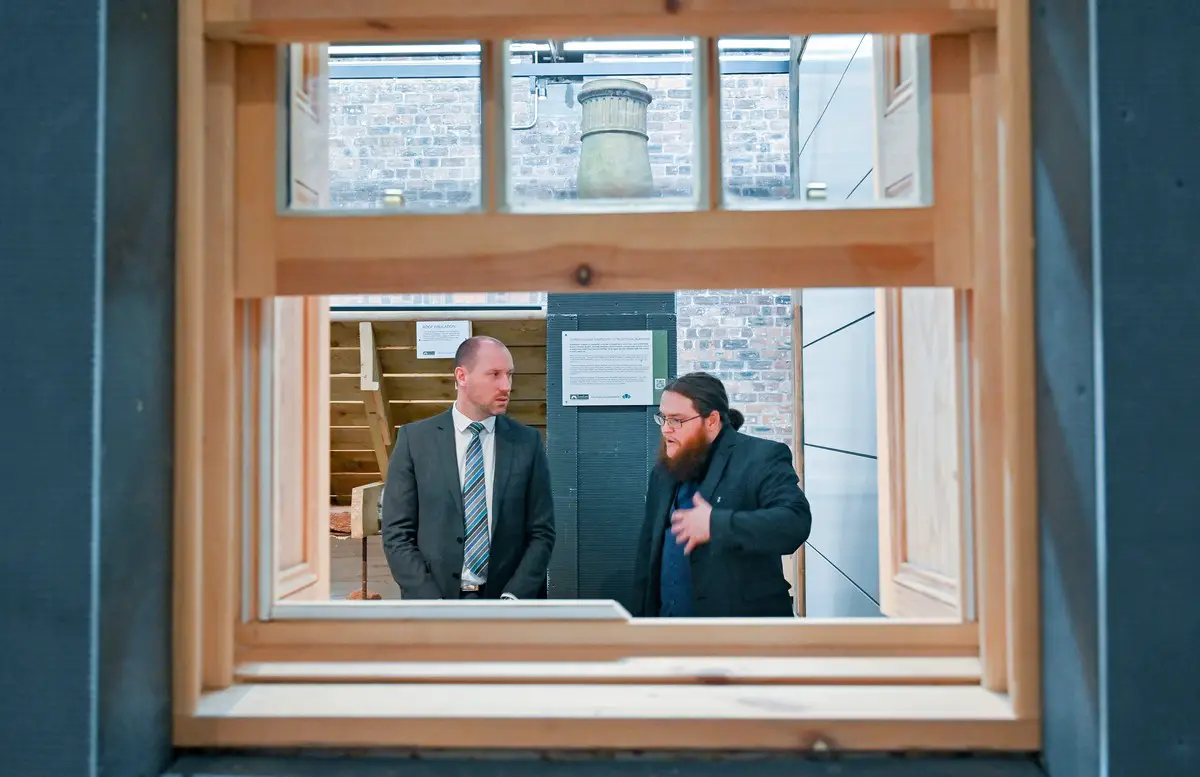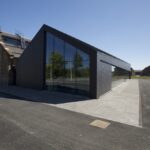The Origami House, Stirlingshire Scotland, Scottish Interior Architecture Images, Building Extension Scotland
Historic Environment Scotland Green Recovery Statement News
2 May 2022
HES sets out vision for heritage-led green recovery
Green Recovery Statement published as Culture Minister Neil Gray visits new Energy Efficiency course at Engine Shed
Culture Minister Neil Gray and Senior Technical Officer Moses Jenkins at Engine Shed:
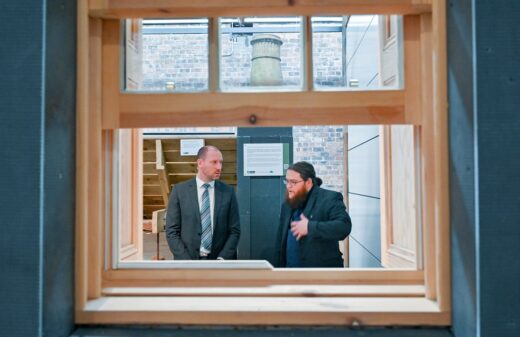
photo courtesy of HES
HES Vision for heritage-led green recovery in Scotland
Historic Environment Scotland (HES) has set out its vision for how heritage can be the keystone of Scotland’s green recovery with publication of its Green Recovery Statement for the historic environment on 26 April.
The historic environment sector, and the traditional materials, construction methods and skills that go with it, provide over 5,000 years of accumulated knowledge and practice of how to live sustainably. The statement sets out how Scotland can use this past to support its future, highlighting key areas where the sector – both the traditional built environment and wider intangible cultural heritage – can make a vital contribution to sustainable economic recovery across policy agendas, including traditional skills and jobs, digital connectivity and responsible tourism.
While sounding this call to action for the historic environment sector, HES is emphasising that the potential of the historic and built environment must be fully realised in order to lower emissions and achieve net-zero targets. The organisation is calling for the maintenance and adaptation of the built environment to be prioritised to make best use of existing embodied carbon, and to minimise the environmental cost of new construction.
The statement outlines how making use of what we already have through the repair, reuse and retrofit of the existing built environment can support sustainable living and reduce carbon emissions. In addition, the maintenance of traditional buildings delivers good, green jobs and skills, and supports heritage-led regeneration to create resilient communities with a distinct sense of place.
With the importance of heritage to Scotland’s tourism economy, the statement also highlights the lead role the sector has to play in driving responsible tourism that can make better places for people both to live in and visit. Land management and the role of the historic environment in supporting biodiversity is also a key focus, as well as the importance of harnessing digital technology to protect historic places and open them up to new audiences in innovative ways, such as the creation of interactive digital 3D models that allow users to virtually visit historic sites from home.
Culture Minister Neil Gray visits Engine Shed as HES publishes its Green Recovery Statement for historic environment:
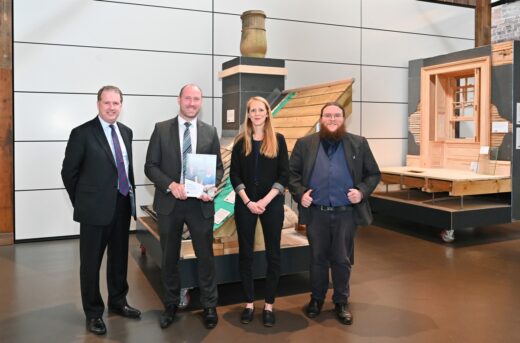
photo courtesy of HES
The statement has been published to support the wider historic environment sector to galvanise action towards green recovery; help organisations and groups showcase the work they are already doing in these areas and demonstrate the potential of the sector to provide the solutions required for Scotland’s just-transition to a low-carbon, climate-resilient economy that is fair for all.
The publication comes as Minister for Culture, Europe and International Development Neil Gray visited the Engine Shed, Scotland’s national conservation centre, in Stirling. He met learners from Warmworks – the managing agent of the Scottish Government’s national fuel poverty scheme – as HES begins delivery of the qualification Level 3 Award in Energy Efficiency Measures for Older and Traditional Buildings. This qualification is a key component of HES’s commitment to supporting net-zero through the retrofit of traditional buildings.
The course is included in the requirements for various standards related to retrofit and will directly support the work of Warmworks and similar organisations to provide insulation and efficient heating to households struggling with the cost of high energy bills. It will provide learners with expert advice and guidance on the range of energy efficiency measures available for older and traditional buildings and how these can be appropriately installed.
The qualification will also help ensure the wider construction industry is equipped with the skills required for the retrofit of Scotland’s existing built environment, which will play a key role in reducing carbon emissions and achieving climate goals. Traditional buildings make up around 20% of the nation’s housing stock, making it crucial to reduce the energy they use and the carbon they emit in order to meet national net-zero targets. Repairing, reusing and retrofitting these existing buildings contributes to a circular economy, which offers a sustainable alternative to building new, and one which also supports green jobs, develops traditional skills and materials and boosts local supply chains.
Alex Paterson, Chief Executive of HES, said: “Scotland faces a number of challenges on the road to sustainable economic recovery and net-zero, but we also have an opportunity to champion our historic environment and its potential to deliver solutions and provide a source of resilience for communities as we work together towards a green recovery.
“We want our Green Recovery Statement to be a tool for the sector to help articulate the ways in which the historic environment supports green principles and contributes to key policy agendas. We want to give the sector a collective voice to better inform policymaking and infrastructure investment decisions.
“Our new Energy Efficiency course is an excellent example of this vision in action, showing how we can collaborate to develop and deliver vital skills that will make a real difference to communities across Scotland.
“We look forward to building and strengthening partnerships, both within the historic environment sector and with wider Scottish society, as we work towards our vision of a sustainable Scotland with a flourishing historic environment at its centre.”
Culture Minister Neil Gray said: “I welcome Historic Environment Scotland’s Green Recovery Statement which recognises the importance of maintaining our historic and built environment in a sustainable way to support our transition to net zero and a climate-resilient economy.
“I enjoyed visiting the Engine Shed and was especially pleased to meet some of the learners who are taking the qualification in Energy Efficiency Measures for Older and Traditional Buildings.
“Innovative approaches like these are vital not just to protect our heritage for future generations but to preserve traditional skills, create jobs and promote resilient communities.”
Ross Armstrong, Warmworks Chief Executive, said: “We are pleased to be part of the training provided by HES. It is extremely important to us that we continue to review and refresh our skills base and look for opportunities to improve.
“By ensuring our assessors remain fully equipped to advise on new, renewable technologies for all types of housing and buildings – including traditional buildings – we can confidently say that we are supporting an inclusive, just transition towards low carbon living.”
The Green Recovery Statement for the historic environment can be viewed on the HES website. For more information on the Level 3 Award, Energy Efficiency in Older and Traditional Buildings, visit the Engine Shed website.
About Historic Environment Scotland
Historic Environment Scotland (HES) is the lead public body charged with caring for, protecting and promoting the historic environment. HES is also the lead on delivering Scotland’s first strategy for the historic environment, Our Place in Time.
Historic Scotland, Scran, Canmore, The National Collection of Aerial Photography (NCAP), The Engine Shed, Stirling Castle and Edinburgh Castle are sub-brands of Historic Environment Scotland.
Historic Environment Scotland Green Recovery Statement images / information received from HES
Location: Scotland
Scottish Architecture
The Origami House
Architects: Loader Monteith

photo : dapple photography
The Origami House, Stirlingshire
Architects: Brown + Brown
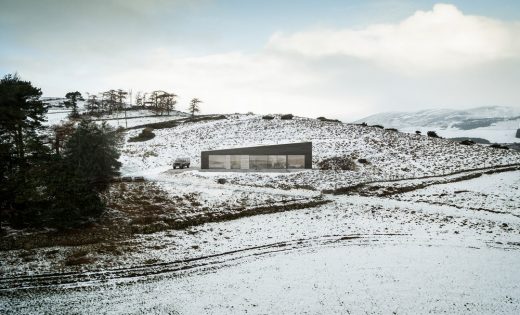
image : Touch 3D
Contemporary Property in Cairngorms National Park
Macallan Distillery in Speyside, Northern Scotland
Design: Rogers Stirk Harbour + Partners
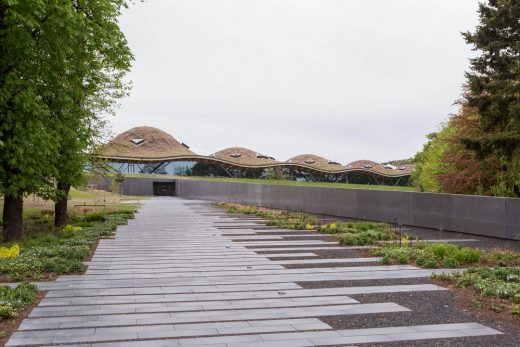
photograph © Simon PricePA Wire
New Macallan Distillery in Speyside, Scotland
Comments / photos for the Historic Environment Scotland Green Recovery Statement news page welcome

